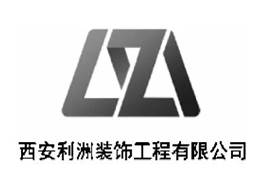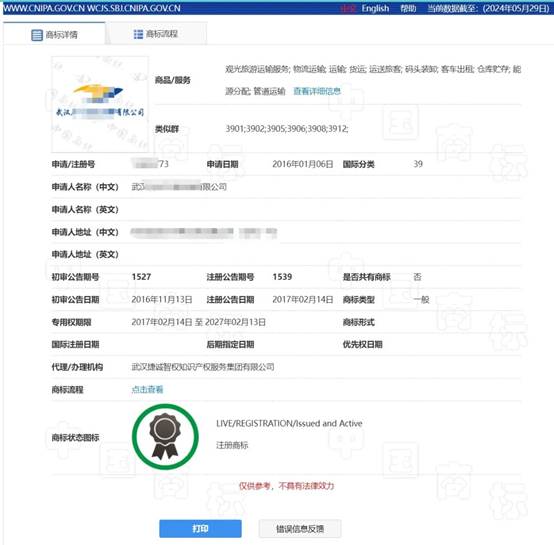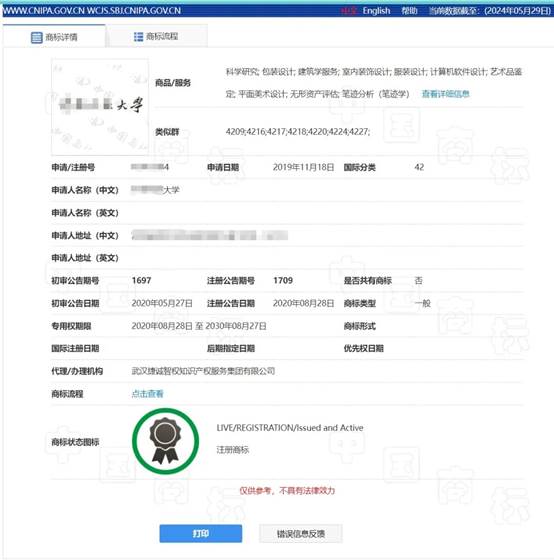Many enterprises, institutions and organizations intend to apply for trademark registration using their full names. However, it is found such operation is subject to high risk of being rejected due to the existence of similar trademarks and lack of distinctiveness, with the latter being the main reason. What is the distinctiveness of a trademark and what are the differences between trademark and business name? Why would the trademark registration of the full name of a business be rejected due to lack of distinctiveness? Can the full name of a company be registered as a trademark, and how? May the following article reveal the answers. |
A. Analysis of Trademark Distinctiveness
A company name is a text symbol that distinguishes a specific company from other companies. A trademark is a sign that can distinguish the goods or services of a natural person, legal person or organization from those of others. Therefore, the identification functions of a company name and a trademark are different and the identifiability of a business name cannot replace the distinctiveness of a trademark, which is an important condition for a trademark to be registered.
Moreover, Article 11 of the Trademark Law stipulates that the following signs shall not be registered as trademarks:
(1) Only consisting of common name, graphics and model of the product;
(2) Only directly expressing the quality, main raw materials, functions, uses, weight, quantity and other characteristics of the goods;
(3) Others lacking distinctive features.
If the signs listed in the preceding paragraphs acquire distinctive features through use and are easy to identify, they may be registered as trademarks.
In other words, whether a business name consisting of only words can be registered as a trademark or not depends on whether it possesses trademark characteristics and distinctive features, and whether it is convenient for consumers to distinguish the goods or services designated by the trademark from other goods or services. And the provision indicates that the distinctiveness of trademarks could be obtained through two ways: inherent distinctiveness, distinctiveness acquired through use.
Inherent distinctiveness is the natural and basic part of a trademark. For example, “天堂” (Paradise) was used to name a brand of umbrella, and the trademark “ ” was successfully registered since relevant public can distinguish the source or the provider of the goods based on general attention.
” was successfully registered since relevant public can distinguish the source or the provider of the goods based on general attention.
Distinctiveness acquired through use requires the trademark of no inherent dominance to obtain its own distinctiveness through continuous practical application. For example, “小罐茶” (small can of tea) is used to describe the scale or capacity of products of tea or tea drinks. When the relevant public sees this trademark, the first thing they think of is the container used for the tea, but less likely to take it as the specific provider of the product. Under the circumstance, the trademark applicant provided a large amount of evidence to prove that after years of continuous use and promotion, the trademark “小罐茶” has established a solid corresponding relationship with the applicant, and can objectively play the function of source identifying. Finally, the trademark was successfully registered.
As for those registration applications where the trademark only consists of the full name of the applicant (natural persons are excluded), Article 3.3.10 of the Guidelines for Trademark Examination states that such application is not accord with the requirement of distinctiveness, such as “湖北宏业百顺建材有限公司”. However, for those trademarks containing elements of graphics or others besides full name, registration may be approved since the whole trademark takes on the significant feature of distinctiveness, take the following two trademarks for example:


It is worth noting that if the full names of public institutions and other organizations having been used for a long time and thus forming a one-to-one correspondence with the designated goods or services will be deemed to having the distinctive features of a trademark, since these trademarks will not cause confusion among consumers, and can indicate the source of the goods or services. For example: trademark “ ”designates the services of school education, book publication etc.; trademark “
”designates the services of school education, book publication etc.; trademark “ ” designates the services of hospital, medical care, educational assessment etc.
” designates the services of hospital, medical care, educational assessment etc.
B. Relevant Case and Result of Examination
On June 14, 2023, Dalian Yijia Business Hotel Co., Ltd. submitted the application No. “72218444” for trademark registration of “大连怡嘉商务宾馆有限公司” designated in Category 38 to the Trademark Office of China National Intellectual Property Administration, but was rejected.
The applicant refused to accept the result and requested for reexamination as that the applied trademark was originally created by the applicant and possessed noticeable distinctiveness and high recognizability. The applied trademark has gained a certain degree of popularity and distinctiveness through use by the applicant, and has established a unique corresponding relationship with the applicant. Evidence of use was submitted during the reexamination.
The final review concluded that the applied trademark only consisted of the full name of the applicant and did not have the distinctive features of a trademark, so it should not be registered as a trademark. The evidence submitted by the applicant was insufficient to prove that the applied trademark had acquired distinctive features through use and was not identifiable enough to be registered as a trademark. In accordance with Article 11.1 (3), Article 30 and Article 34 of the Trademark Law of the People’s Republic of China, the application for trademark registration shall be rejected.
As far as this case is concerned, the only element in the company name that can meet the distinctiveness requirements of the Trademark Law is “怡嘉” (Yijia), which has no exact designation or meaning. As for other words, “大连” refers to the administrative division Dalian, “商务宾馆” (business hotel) refers to the industry it is engaged in, “有限公司” (Ltd.) refers to the organizational form of the enterprise. If there is no conflict with the prior rights of others, only the word “怡嘉” has inherent distinctiveness as a trademark.
C. WEIPR Successfully Agented Trademark Registered in Full Name
When agenting a trademark registration for a traveling company, it was found after search that the applicant’s business name formed no conflict with any prior rights of others in Class 39. At the same time, WEIPR suggested that the applicant apply for trademark registration using the combination of their logo and the company name, which greatly increased the registration success rate and ultimately the trademark was successfully registered.

In the other case, as the applicant’s name was XX University, according to the Guidelines for Trademark Examination, if the full name of institutions and other organizations has been used for a long time, has formed a one-to-one correspondence with the designated goods or services, and will not cause confusion and misidentification among consumers and the source of the goods or services can be identified, then it is regarded as having the distinctive features of a trademark. WEIPR suggested to apply directly, and the trademark was successfully registered in the end.

D. Conclusion
As mentioned above, it is often difficult to succeed in trademark registering if the applicant only uses the full name of a company as trademark. The following occasions are concluded to improve the success rate of registration:
1. Provide evidence of use. Take the trademark case No. 11448304 for example. The applicant Shanghai Lianya Investment Consulting Co., Ltd. applied registration using its full name of “上海联雅投资咨询有限公司” and was rejected at the first attempt. After their persistent efforts of requesting for reexamination, first and second instance of administrative litigation, providing a large amount of use evidence to prove that the trademark had acquired distinctiveness through use, finally they got their trademark registered. However, it is very likely to be rejected to register only the full name of a company as a trademark due to lack of distinctiveness. The requirement of providing use evidence is relatively high and the process is time-consuming and laborious;
2. The applicant’s full name is the full name of public institutions and other organizations, which has acquired distinctiveness after long-term use;
3. Apply for trademark registration using combination of the logo and the full name of a company. As long as the company name does not conflict with the prior rights of others, it is likely to be deemed as possessing distinctiveness and identifiability, and thus earns higher registration success rate.
